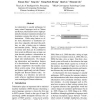Free Online Productivity Tools
i2Speak
i2Symbol
i2OCR
iTex2Img
iWeb2Print
iWeb2Shot
i2Type
iPdf2Split
iPdf2Merge
i2Bopomofo
i2Arabic
i2Style
i2Image
i2PDF
iLatex2Rtf
Sci2ools
COLING
2010
2010
Joint Tokenization and Translation
As tokenization is usually ambiguous for many natural languages such as Chinese and Korean, tokenization errors might potentially introduce translation mistakes for translation systems that rely on 1-best tokenizations. While using lattices to offer more alternatives to translation systems have elegantly alleviated this problem, we take a further step to tokenize and translate jointly. Taking a sequence of atomic units that can be combined to form words in different ways as input, our joint decoder produces a tokenization on the source side and a translation on the target side simultaneously. By integrating tokenization and translation features in a discriminative framework, our joint decoder outperforms the baseline translation systems using 1-best tokenizations and lattices significantly on both ChineseEnglish and Korean-Chinese tasks. Interestingly, as a tokenizer, our joint decoder achieves significant improvements over monolingual Chinese tokenizers.
Related Content
| Added | 13 May 2011 |
| Updated | 13 May 2011 |
| Type | Journal |
| Year | 2010 |
| Where | COLING |
| Authors | Xinyan Xiao, Yang Liu, Young-Sook Hwang, Qun Liu, Shouxun Lin |
Comments (0)

